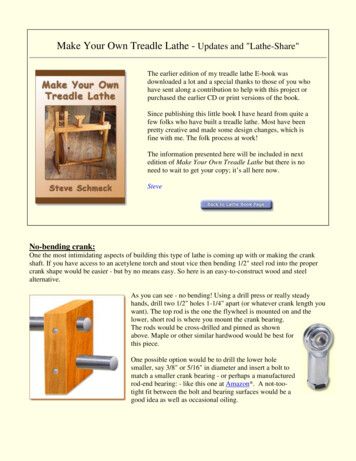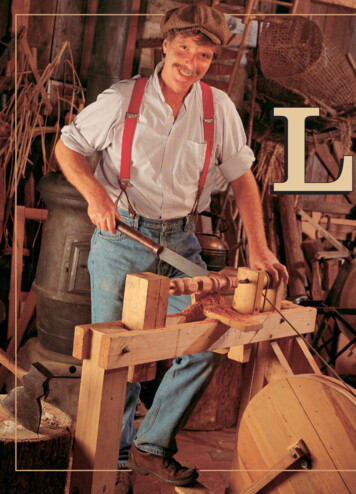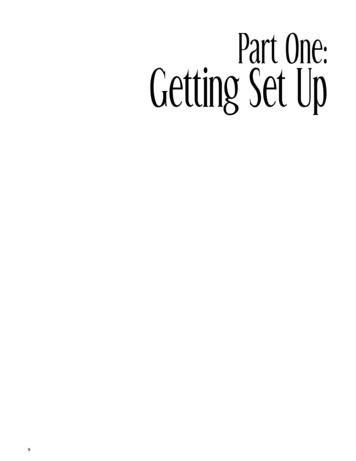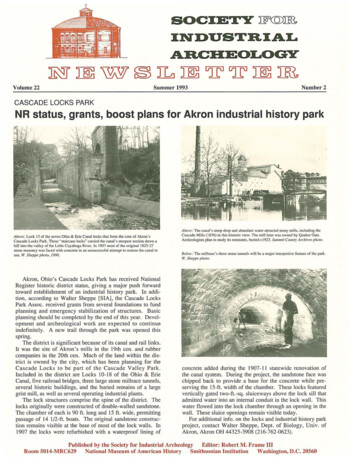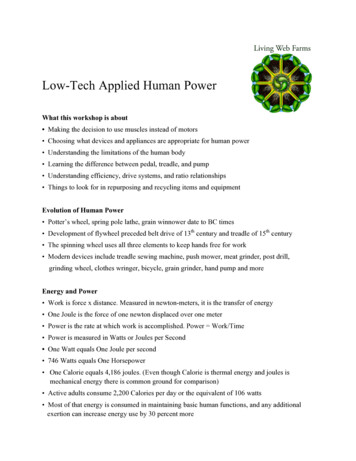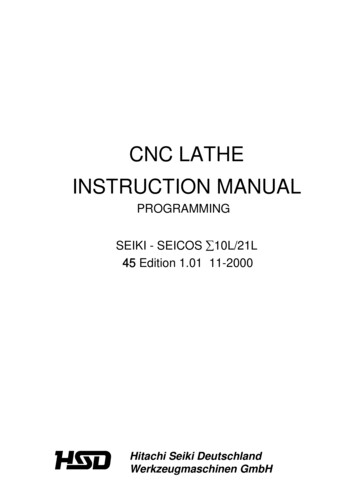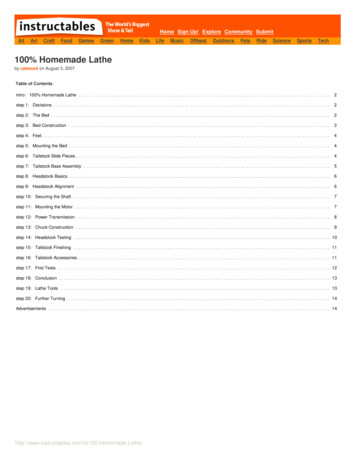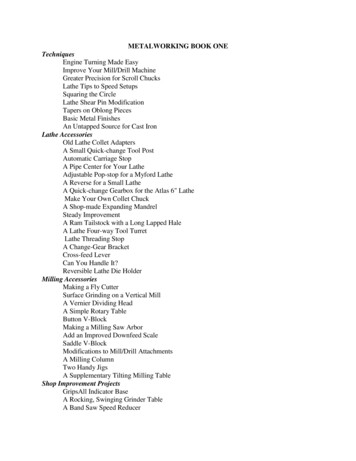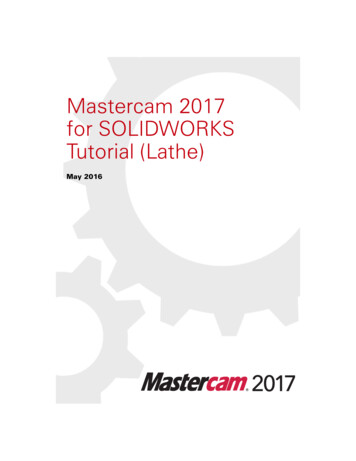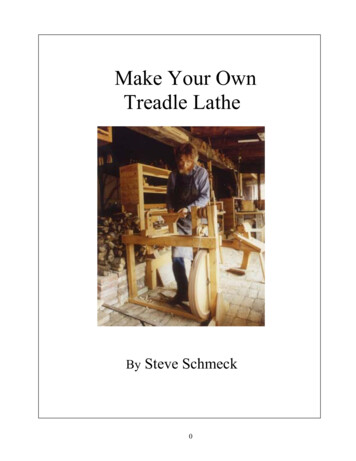
Transcription
Make Your OwnTreadle LatheBy Steve Schmeck0
Copyright 2005 by Steve SchmeckPublished by ManyTracks PublishingAll rights reserved.Permission to reproduce portions of thisbook may be obtained from the publisher or author.Inquiries should be addressed to ManyTracks Publishing,770N Fox Road, Cooks Michigan 49817.telephone: 1-906-644-2598e-mail: mt@manytracks.comwww.manytracks.comYou can help.ISBN: 0-9652036-7-0ESBN: 81897-050218-122102-14Library of Congress Control Number: 2005922672Print version printed on 100% recycled, acid-free paper.E-Book Updated 2/22/20051
IntroductionMake Your Own Treadle LatheWhy this small book existsIn the last twenty years or so since I built this foot-poweredtreadle lathe, I have received many requests for drawings orplans. The lathe has been used as part of our traditionalwoodworking demonstrations and it never fails to draw acrowd. Of course, the reason the lathe exists is because I felta need for it as a tool.Design considerationsSome of the main considerations when designing the lathe were: Human powered -- our solar energy system was pretty small at the timeSize -- it had to be less than 42" tall to fit into our old truckCompact -- since it would sit in our small shop all the time, a small footprint wasessentialPortable -- as in not too cumbersome or heavyFunctional -- it had to perform the basic duties of a light-duty latheAdaptable -- I had in mind several untraditional uses for the tool, like sandingBackgroundDuring a demonstration at a Steam and Gas Antique Village many years ago, I had theopportunity to use a monster treadle lathe with a 6' diameter wood flywheel and 8' longbed. This old timer had been used during the lumbering boom years in Michigan'sUpper Peninsula to turn decorative porch posts for some of the fancier "LumberBaron's" homes. As you might guess, it took a lot of energy to keep that big, heavywheel turning, even when the piece you were turning was not particularly large.I had built a couple of spring pole lathes for use in the shop and on the road atdemonstrations. One used an ironwood pole lashed in the shop's rafters, and the portableunit used a bungee shock cord for recoil power. Spring pole lathes are cool andalthough their unique intermittent cutting action required a bit of getting used to, theydid a lot of turning of both spindles and some small plates. Eventually, though, I wantedan easier way to demonstrate the use of a lathe to turn the tubes of a series of woodenflutes I was making. A treadle lathe with its continuous cutting action was my nextproject.MaterialsI wanted to use materials I had on hand to build the lathe. Luckily I had recently had alocal sawmill cut and dry some 3x3's and 2x4's from a large maple cut in our woodlot.Although I used this more or less uncommon stock, there is no reason a decent lathecouldn't be made from regular dimensioned 2x lumber. The denser and more durable thebetter. I would think that something like yellow pine would be very good.This booklet can be used to guide you through the construction process, step by step or,2
if you like, just to help you see one way the design and construction challenges ofbuilding a human-powered lathe were handled.Where from here?If you are reading this in digital format you can use the index at the left to move throughthe construction process. Click on any of the heavy-bordered photos accompanying thetext to see an enlarged view or select a graphic from the list at the lower left. If you arereading this in a printed form and would like to obtain a free, up-to-date digital version(E-Book or PDF), aim your Internet browser at www.manytracks.com/lathe.I hope you enjoy this project and that it helps you to build your own human poweredtreadle lathe.Lathe - Front ViewMake Your Own Treadle Lathe3
Lathe - Flywheel End ViewMake Your Own Treadle LatheLathe - Measured DrawingMake Your Own Treadle Lathe4
Materials & PartsMake Your Own Treadle LatheI have listed below the materials and parts used in thebuilding of this lathe. In a few places I have listed options oralternatives based upon experience I've had using the latheover the last 20 years. In general it has done what I asked itto do but there are a few things I would change and havenoted them here and in the building process text. Thematerials are based upon stock I had on hand and thedimensions shown work for my 5'-10" height frame. Feelfree to modify either materials or dimensions to fit your ownneeds.Click for Measured DrawingWood:I used maple for all wood parts except as noted below. All lumber dimensions arenominal, that is, 3x3's actually measured 2¾"x2¾", 2x4's measured 1½"x3½".Headstock Uprights: 2 - 3x3 x 38½"Tail Upright: 1 - 3x3 x 27½"Ways: 2 - 2x4 x 42"Base: 1 - 2x4 x 40½"Stabilizer: 1 - 2x4 x 24"Headstock End Brace: 1 - 1x10 x 12"Tailstock: 1 - 2x4 x 18"Tailstock Braces: 2 - 1x3 x 6"Flywheel Center: 1 - 1x8 x 8'Flywheel Rim: 2 - 1x6 x 6' - (cherry)Treadle: 1 - 1x2 x 28"Tool Rest.Upright: 3x3 x5"Top: 2x4 x 8" (could be longer)Base: 1x4 x 12"Spacer: 3x3 x 3"Clamp-piece: 1x4 x 6"Parts:Spindle Shaft: 8" x ½" steel rod ( Optional 8" x 5/8" or larger diameter)Spindle Pulley: 3" Diameter adjustable pulley ( or pulley to fit your belt )Flywheel Centers: 2 - 3/8" plumbers floor flanges - ( or sized to fit your crank shaft )Crank Shaft: 11" x ½" steel rod (I used crank arm from old Singer treadle sewingmachine)Treadle Connector 11" x ¼" threaded rod (Mine came from above sewing machine)Tool Rest Adjusting Bolt: 3/8" x 6" Carriage Bolt - with square nut & flat washerTool Rest Post Pivot: 5/16" x 3" lag screwLeather belting: Singer treadle sewing machine replacement belts (2)5
HeadstockMake Your Own Treadle LatheLooking back at some of the reference books in my library, I was struck by the relativesimplicity of some of the old treadle lathes. I have had some experience with hardwoodbearings and had originally planned to go that route on this lathe.In the early years here on our homestead our alternativeenergy system was pretty small; too small to run largershop tools. To solve this problem, I set up a line shaft atone end of the shop. It was made of a ten foot long, 3/4"diameter cold rolled steel shaft supported by three maplebearings. It was powered by a gasoline engine justoutside the shop. With six horsepower spinning thatshaft it ran my Shopsmith, jointer and band saw justfine. I had a throttle control and engine cut-off on theinside wall which gave a lot of control over tool rotationspeed. I'd guess that a good part of that six horsepowerwas used to overcome the friction in those bearings.CLICK FOR LARGER IMAGEWith just my right leg to power the lathe, I decided I'dneed as little friction in its shafts as possible so Icompromised a bit on authenticity and designed theheadstock around a pair of light-duty sealed ballbearings. If I was to do it over, the only change I'd makehere would be to use a larger, perhaps 5/8", diameterspindle. There are two reasons for this; the additionalmass of the larger spindle would increase its flywheeleffect, and 5/8" plain-shaft accessories like drive centersand chucks are more readily available.Layout and ConstructionYou can see from the drawing at right how the bearings and spindle are set up. Beforethe uprights are fastened in place you will want to lay all three 3x3's side by side, withthe base 2x4 across their bottom ends, and draw a line across them 30" up from thebottom of the base board. This is the height of the top of the ways on my lathe.You may want to adjust this to match your most comfortable working height. Onthe two longer uprights measure up another 8" to establish the spindle's center above theways. Carry the lines around on all four sides of each upright with a try square. On theleft upright mark the center and bore a hole the size of the outside of the bearing and asdeep as the bearing is thick. I used an old adjustable auger bit which nicely also cleanedout the hole. An appropriately sized Forstner or paddle bit could also work well.Repeat this on the center upright and then continue through it with a bit largeenough to clear the spindle's shaft completely. In my case, I used a ¾" bit for my½" shaft. The bearings are retained in place by a couple of pan-head screws,placed 180 from each other just outside the edge of the hole.While working with these pieces use the same procedure to lay out and install the6
flywheel bearings. These are centered in the space between the base 2x4 and the bottomof the ways; 12½" up from the base on my lathe. I happened to mount my flywheelbearings on the inside or wheel-side of the uprights but could just as easily have laidthem out on the right sides as were the headstock bearings.Headstock Close-upMake Your Own Treadle Lathe7
Headstock Detail DrawingMake Your Own Treadle LatheHeadstock Close-up (2)Make Your Own Treadle Lathe8
TensionerMake Your Own Treadle LatheDepending on the type of belt you decide on, you may need a belt tensioning device ofsome kind. My belt is made from a couple of Singer treadle sewing machine belts cutand joined to fit the lathe.The Belt: My belt is made from two Singer sewing machine belts,long loops of leather with a cross-section of about ¼" in diameter.to hold the ends ofSinger used a small metal staplethe loop together. I used this system for a while but found it wasprone to break during critical moments during publicdemonstrations. After several experiments, I found that a better wayto join the belting was to sew the ends together using nylon artificialsinew.This also had the advantage of going throughthe top pulley more smoothly.The Tensioner: The solution I came up with to keep a moderate amount of tension on thebelt was a spring-loaded, pivoting frame holding a lathe-turned (need a lathe to make alathe?) idler pulley. The 'U'-shaped frame pivots on a ¼" dowel and is tensioned by awimpy, found, coil spring (barely visible below the frame in the photo). Although thespring arrangement works OK is looks a bit cheesy and might be done more elegantly withsome sort of system with adjustable weights on the idler. I put a short section of ½" dowelon the end of the pivot dowel to make it easier to remove or adjust.The idler wheel runs on a couple of very small ball bearings scavenged from an oldcomputer disk drive, but any small bearings or even a nice little bronze bushing wouldwork well. The whole point here is to keep just the right amount of tension on the belt toavoid slippage, without adding any unnecessary friction into the system.This is a place where you might say "I can do better than that!", and you are probably right.This tensioner has worked well for me for many years but I'm sure there are other ways tosolve the belt slipping problem.As an aside, the old monster lathe I mentioned in the introduction had a unique slippageproblem and solution. The attack angle of the belt coming off that big six foot flywheel to a4" drive pulley didn't provide much traction area on the small pulley [ 'A' below]. Thesimple solution was to loop the narrow belt (a loop of hemp rope) around the small drivepulley and reverse the direction of rotation of the flywheel [ 'B' below]. It looked and feltweird with that big wheel going 'backward', but it worked quite well.AB9
Tensioner Close-upMake Your Own Treadle LatheTailstockMake Your Own Treadle LatheThe tailstock is made from an 18” long 2x4. For the part that restson the ways I cut a rabbet in a 6” piece of 3x3 and doweled andglued the pieces together. This is another case of “If I had it to doover again”. For simplicity’s sake and to add a bit of rigidity, I’dnow attach a 1x3 on either side of the upright piece as shown onthe Measured Drawing.Mark the center height by sliding the tailstock up to the end of theshaft. I had a fixed cup center from my old Shopsmith so I drilleda 1” hole to mount it in. You could also use a good #2 Morsetaper live center. If you do, drill a 9/16” hole and carefully use arat-tail file and sandpaper wrapped around the center’s shaft totaper the hole.10
Then again, you could do as I did on my old spring pole lathe. I used a 1/2" x 8" lagscrew, with a sharp 90-degree bend in it for a handle. I drilled a 7/16" pilot hole, heatedthe screw red hot with a propane torch and burn/screwed it into place. With the pointreshaped into a smooth, blunt cone and a little paraffin wax rubbed on the threads andpoint, the "center" worked just fine.A tapered wedge running through a mortise in the tailstocksecures it to the ways. The drawing on the right shows the shapeand position of the mortise relative to the bottom of the ways.You can chop put the mortise with a ½" chisel or drill it out andclean up the sides with wider chisels. Make the wedge from a 7"x 2¼" piece of ½" hardwood. The narrow end tapers to 1½"wide and the bottom of the mortise matches this angle. Drill ahole an inch from the end of the wedge and insert a short pieceof dowel to keep it from falling out during adjustment.Tailstock Close-upMake Your Own Treadle Lathe11
Tool RestMake Your Own Treadle LatheOne of the projects I was working on at the time I designed thislathe was a series of wooden flutes. The blanks were split outby hand and bored by hand but I had been using my oldShopsmith as a lathe for shaping the outside. Not verytraditional and certainly not very portable. I wanted to be ableto be able to turn these on the treadle lathe.The original tool rest top was about 14" long to facilitateturning those tubes but was not as steady as I would have liked.In the photos you can see a couple of hangar bolts in the rightupright and tailstock. These hold a slotted-for adjustabilityhardwood 1x2 which acts at a tool rest for the flutes. The topshown here was installed later to use in faceplate turning of aset of cherry plates.Tool Rest DesignThe close-up photos show the structure of the tool rest assembly. The top piece can beinterchanged with longer, shorter, or specialty tops. Just about the only thing that doesn'tshow in the photos is the fact that the vertical post rotates on a lag bolt, the head of whichis recessed into the base piece that spans the ways. This allows the tool rest to face parallelto the ways for spindle work or be rotated perpendicular to the ways for faceplate turning.There is no vertical adjustment of the tool rest. Once I found a height that worked for me, Ihave been able to live with it for all kinds of turning. It wouldn't be too difficult to designheight adjustability into the support post, but I haven't needed it for the kind of turning I'vebeen doing.To create the slot in the base piece drill a hole 3" in from each end, draw guide lines fromhole to hole, and saw along these lines to connect the two holes. I used a traditional turningsaw which looks like a regular old time frame saw but has a narrow, ¼" wide, blade. Acoping saw (slow) or non-traditional saber saw would also work. The slot width isdetermined by the thickness of the square shoulders just under the head of the 6" carriagebolt.The 'wing nut' that tightens the tool rest in place was made by chiseling a mortise in thebottom of a 1" x 1" x4" hardwood scrap to accept a square nut, and shaping the piece toallow finger room.12
Tool Rest Close-upMake Your Own Treadle LatheFlywheelMake Your Own Treadle LatheThe flywheel is made up from a central layer of maple planks witha cherry rim applied to each side. The idea here was to use the rimto hold the wheel together as well as add some more weight at theoutside edge of the wheel where it would do the mostgood. Although it may seem like I was putting the cart before thehorse, I began by making the rims.Rim design & layoutStart by making a template from an 18" x 12" piece of illustration board or similarmaterial. Using a center point half way along one long edge draw two arcs, one with aradius of 12", the other, a radius of 10".Then use a framing square positioned with the point onthe center mark and draw the two quadrant end lines. Asyou can see at left and perhaps better in the larger photo,I fancied up the ends by drawing small arcs intersectingthe inner arc and each end line. For this 24" diameterwheel the template length turned out to be a bit less than18" so four pieces will fit on each of two cherry 1 x 6'sabout 6' long.13
Cut these eight rim sections about 3/8" oversized on the outside arc, being careful to cutthe ends true to the lines. The over-sizing is done to allow some cutting space when theassembled wheel's finished circumference is cut on the band saw.The wheel bodyThe next step is to cut an 8-foot long maple 1x8 into four pieces; two26" long, and the other two 22" long. These pieces are laid out on thebench and clamped down side by side with the longer pieces in thecenter. Draw an 'X' from corner to corner on the middle board toestablish what will become the center of the flywheel. Next use thiscenter point to draw a 10" radius circle on the boards as a guide inlaying out the rim sections. The Flywheel Layout Drawing showsthis better than I can say it.The rim sections are then placed around the inner guide lines. They should be arrangedto give maximum strength by crossing the joints in the maple at as close to a right angleas possible. This is a good time to clean up any ill-fitting rim joints. The rim sectionsare then nailed into place. Although the nails have worked just fine for many years onmy lathe, I now might be tempted to use some nice flat-head brass screws.Before turning the assembly over, drill a 1/16" hole through the center point to transferthe center to the other side of the wheel. Repeat the same procedure; draw 10" radiusguide-circle, lay out then fasten the rim on the other side, staggering the section jointsfor strength.Cut the wheel to shapeUsing a scrap 2x4 about 36" long make a circle cutting jig for your band saw. Firstmake a cut half way through the 2x4 in a position that gives some clamping room to theleft of the blade; about 11" from the left end. Removed the board from the saw andmeasure a point 12" to the right of the saw kerf, centered on the width of the 2x4. Onthat mark drill a 1/4" hole for a 6" long, 1/4" bolt that will act as a pivot point for thecut.Next, re-draw the 12" radius circle and draw a tangential line (just brushing the circle)on the cherry rim and then enlarge the center hole to 1/4". Securely clamp the jig inplace without the pivot bolt to support the wheel while making the initial cut on thattangential line. Then install the bolt up through the jig and wheel center. Adjust thesaw's upper guide as low as practical and cut the wheel to shape. There must be aneasier way, but then again, if you don't have access to a band saw, there are any numberof harder ways. The easiest would probably be to use a good sharp power jig saw.Without power at all one could do a decent job with a narrow blade in a frame saw.14
Mounting the wheelI used the same ½" bearings for the flywheel as I did for my headstock. To make up thewheel's shaft I brazed a section of ½" rod to the crank assembly cut off of our oldSinger sewing machine. This provided both the crank and crank bearing, sort ofsimplifying this aspect of the project. You could make a one-piece crank from hardwarestore round stock by heating and bending it in a sturdy vise. The offset on my crank isonly about 1-¼"; less than I would have thought necessary, but it gives a goodcompromise between speed and torque with the pulley ratios I used (24:3).Build you own crankThis drawing shows the way I would probably put together thecrank 'bearing'. Left-to-right: cotter pin, ½" flat washer, heavyduty ½" washer, flat washer, cotter pin. Braze or weld a ¼"steel rod to the edge of the heavy washer. The bottom end ofthis rod goes through a hole in the treadle and is held there by anut and washer on the underside of the treadle. You want a bitof looseness in all this to allow the treadle to pivot and movearound to a comfortable position beneath the lathe.My hubs are made from 3/8" steel floor flanges sometimes used to support stairwayhand rails. These were bored out to accept the shaft and the right-hand one cross-drilledthrough its hub to accept a heavy cotter pin (or high-tech bent nail), tying the wheelsecurely to the shaft. This arrangement provides adequate stability and has weatheredsome pretty aggressive use without any problems.Finally, groovingOnce the flywheel is mounted and can be rotated easily about its permanent axis, it'stime to cut the groove for the belt. This was the only two-person job on the project.Mount a 'V' bit in your trusty router and clamp its base to a scrap of 1x8 to use as asteady rest. Then, while your assistant (In my case, my wife Sue) slowly rotates thewheel, ease the bit into the center of its outer edge. After several rotations you shouldhave a nice groove deep enough to keep the belt in place. This technique results in agroove which may appear to wander a bit in relation to the edge of the rim due to theflywheel not being absolutely flat or perhaps some minor error in hub alignment, but thegroove should be true to the center of rotation, which is what you are after. I didn't sandthe groove, preferring to leave it a bit rough for belt 'traction'.If you don't have access to a router you could set up a similar system to hold a courserat-tail rasp in place of a router. Hold the rasp against the center of the rim while yourassistant spins the wheel to form the channel. The end result is that the belt runs true anddoes not slip on the flywheel at all.15
Flywheel Close-upMake Your Own Treadle LatheFlywheel Hub Close-upMake Your Own Treadle Lathe16
Flywheel LayoutMake Your Own Treadle Lathe17
Using the LatheMake Your Own Treadle LatheI'll not try to give a lesson in wood turning here but highlight some of the things whichI've found unique to this type of lathe. It might also be helpful to mention some of thenon-turning uses we've come up with.Using a treadle lathe is initially an exercise in hand/foot coordination. If you have everused an old treadle sewing machine you have a leg up, so to speak. The major differenceis that on the lathe you also have to support your weight on your non-pumping leg.Direction of RotationAnother similarity to the sewing machine is thatyou have to motivate the work to turn in theright direction. Depending on crank positionwhen you begin, there is a 50-50 chance that thework will turn away from you rather thantoward you. This 'feature' can be put to gooduse when finish sanding. Only the mostexpensive powered lathes can be reversed tohelp remove those pesky little fibers that laydown in the direction of rotation. On a treadlelathe, just stop pumping and give the work a bitof a boost in the desired direction and go at it.Positioning the stockSince the tails stock on my lathe has no lateral adjustment for securing the work piece, aspecial technique is used. Start out by cutting an 'X' across the driven end and punchinga significant dimple in the center of the tailstock end of the piece. Press the stock firmlyagainst the drive center and slide the tailstock up until it will hold the piece in place.Then slide the tailstock a bit farther towards the headstock (it is now angled backwardsslightly) and firmly tap in the securing wedge. How hard you hit the wedge determineshow tight the stock is secured in the lathe. All this becomes second nature and takes justa moment to do.Non-Turning UsesAlthough the lathe is used for an occasional turningdemonstration, these days it spends most of its time right whereit is in the photo above. in our traditional tool shop. I use itoccasionally to turn a special project but its primary use is as apower source for sanding. We make hand carved wood spoonsduring the long winters here in Michigan's Upper Peninsula anduse the lathe to help sand the insides of the spoon's bowls. Iremove the drive center and replace it with a ½" geared drillchuck. Various shop-made sanding disks are fitted into it andthe unit speeds up that part of the spoon-making processconsiderably. So, the spoons are technically hand carved andfoot sanded.18
I have tried running a flexible shaft from the lathe but found little advantage over justchucking the sanding disk directly in the lathe. Both felt and lambs wool buffing padsalso work well. It is quite easy to adjust the lathe speed to match the needs of your workjust by peddling harder/softer or adjusting the pressure of the work against the sandingor buffing tool.Did you find this information helpful?I hope that the information and ideas I've shared withyou here have been of value to you. If you do build atreadle lathe, I'd enjoy hearing how it turned out? Youcan contact me at:Steve Schmeck770N Fox RoadCooks, MI 49817ORsschmeck@up.netIf you would like to support this and similar projects,please feel free to send along a contribution. Whateveryou feel is fair. Thanks!19
plans. The lathe has been used as part of our traditional . I had built a couple of spring pole lathes for use in the shop and on the road at demonstrations. One used an ironwood pole lashed in the shop's rafters, and the portable . belt was a spring-loaded, pivoting frame holding a lathe-turned (need a lathe to make a lathe?) idler pulley .File Size: 504KB
